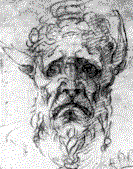 |
|||
|
|||
|
Being 'visually' literate is no less important than being literate in the reading and writing sense. In fact, some may ever agree that 'drawing' should be studied alongside reading and writing. Why? Because before you can write you must learn to draw circles and squares, at least; otherwise how will we make a '3' or '7' ... and 'S' or an 'Z'? So how
does someone become visually literate? Drawing literacy
can best be understood in the absence of language... and its effect can
be quite potent. A test might be... 'Using the quickest, simplest drawing and the minimum number of lines you can imagine, draw as economically as you can any of the things on the following list:
NO AGE LIMITS: These tests could be given to children as young as five and adults as old as eighty and the results may well determine their 'active visual literacy'. There may somtimes also be little difference in the results. I would test for speed and inventiveness just as a you might judge some prose thus. Bear in mind the teacher need not be Leonardo or Rubens to satisfactorily judge the results! Let's take this active and passive division little further. In what is 'art' today we have the visually semi-literate - in the 'active' sense; they may however, be quite visually literate in the passive sense. Should they be called 'artists' - and would we be as ready to embrace people who called themselves writers if they attempted to write of their experiences neglecting any structure? I don't think so; and some of my own writing proves just that! Is any of this important to the human species? The children I tested seemed to think so.... maybe such tests need to be given to some of our national art critics... I made a comment once ... when we talk of educating our children in 'the basics' we should mean the basics of reading, drawing, writing ... and perhaps maths; but then I may be a little biased. Imagine beginning every art class with 'OK children, open your sketch pads and do two quick sketches; a coconut and a saw. You have three minutes..... then we will be finishing off the drawing we started last week. Well this is exactly what we shall now be doing wilth our drawing course. Time- Lessons separated into approx 40 min segments. Homestudy - 10 to 20 minutes per lesson - set work proposals suggested at end of each lesson. Materials;
New
General lesson structure; 
|

